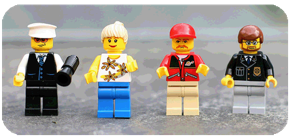In an earlier newsletter, we included a story about how Lego built its mighty block empire on a strong foundation of licensed products. The Danish company continues to make a variety of sets with characters from popular franchises like Star Wars and Harry Potter, accounting for a third of Lego’s sales. As the toy company became more dominant in the last year, however, it started to focus more on promoting its own brand rather than others’. The 2014 The Lego Movie began this turnaround in style, putting the building block brand on the same big screen as its licensing partners.
Much of Lego’s recent success can be attributed to its dedication to research and development. In fact, the company’s Future Lab department knows as much about the playing habits and behaviors of children as many universities. Staffed by academics, child psychologists and statisticians, the Future Lab conducts detailed ethnographic studies of kids around the world about how they interact with toys. In one instance, researchers found that boys tended to be drawn to Lego playsets featuring characters with a strong narrative. Girls, on the other hand, tended to use their toys to role-play. This led to the creation of Lego Friends, the company’s first major product line directed at girls. Featuring more general settings like a broadcast news van and a wildlife rescue site, these colorful playsets are already a major hit.
What’s more, the Future Lab has found that children today no longer make a meaningful distinction between digital play and physical play. With Legos placed on the same plane as iPads and video games, the company is looking to combine these two worlds into what it calls “One Reality.” The first products to launch from this philosophy are being branded as Lego Fusion, which lets kids manipulate their creations on an accompanying app. Children aren’t Lego’s only target market, though. Product lines like Lego Architecture are directed at adults whose love for the building blocks never faded. With sophisticated subjects like the Sydney Opera House, these sets also allow Lego to charge adult-sized prices for products containing the same amount of materials as their juvenile counterparts.
Questions:
- What has Lego’s learned specifically from its extensive research?
- Can we expect more movies based on the Lego brand?
Source: Jonathan Ringen, “How Lego Became the Apple of Toys,” Fast Company, January 8, 2015. Photo by: Dan Goodwin.

